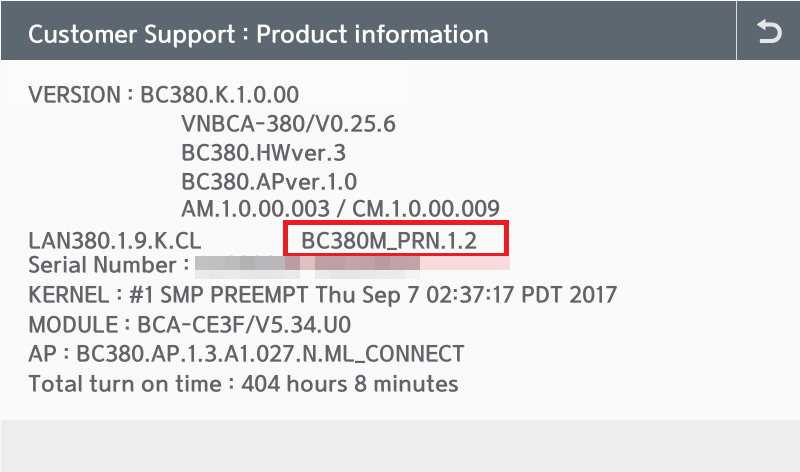-
[Body Composition Analyzer] I want to print my body composition results, what are the supported printer devices?
-
ACCUNIQ body composition analyzers support different types of printers depending on the model and version.
You can check the model name of your supported printer by following the steps below.
1. Tap the settings button (gear) at the bottom of the standby screen on your ACCUNIQ device to enter settings (password required).
2. Go to Settings > Customer Support > Product information.
3. On the [Product information] page, look at the red box at the bottom and you will see the printer library version next to the model name.

4. Depending on the library version, the supported printers are listed below.
[ PRN.1.0 ]
- Samsung: SL-M2026, SL-M2020, SL-2029, SL-M2035, SL-M2035W, SL-M2620ND, SL-M3320ND, SL-C1810W
- Brother: HL-L2360DN, HL-L2365DW, HL-L2370DW, HL-L2375DW, HL-L5000
- HP : P2035, M203DW, 107, M404, M428
[ PRN.1.2 ]
- Samsung : SL-M2026, SL-M2020, SL-2029, SL-M2035, SL-M2035W, SL-M2620ND, SL-M3320ND, SL-C1810W
- Brother : HL-L2360DN, HL-L2365DW, HL-L2370DW, HL-L2375DW, HL-L5000
- HP : P2035, M203DW, 107, M404, M428
Pantum : P3301DN
[ BC380JP_PRN.1.2, BC380M_PRN.1.2, BC720M_PRN.1.1 ]
- Samsung SL-M2026, SL-M2020, SL-2029, SL-M2035, SL-M2035W, SL-M2620ND, SL-M3320ND, SL-C1810W
- Brother HL-L2360DN, HL-L2365DW, HL-L2370DW, HL-L2375DW, HL-L5000, HL-L2460DW
- HP P2035, M203DW, 107, M404, M428
-
[Body Composition Analyzer] If a child or adolescent is taking body composition measurements, can I use an adult result sheet?
-
For children and adolescents, we recommend using the result sheet for child and youth. If you are measuring using the adult result sheet, please note that some items may differ from the standard range for children and adolescents.
-
[Other Products] ACCUNIQ APP cannot be found in the Google Play Store.
-
The new ACCUNIQ Connect app was launched in October 2023. Thus, the existing ACCUNIQ app cannot be searched in the Google Play Store.
If you would like to download, please click the link below or take a photo of the QR Code.
<Download ACCUNIQ APP on Android phone>
https://play.google.com/store/apps/details?id=kr.co.bca

-
[Blood Pressure Monitor] How often should I calibrate my blood pressure monitor?
-
The sphygmomanometer does not require any additional calibration after purchase. The zero point is also automatically zero, so you don't need to set it.
-
[Blood Pressure Monitor] What is cardiac strain?
-
Your heart rate is your maximum blood pressure multiplied by your pulse rate. The higher the peak blood pressure and the faster the pulse rate, the higher the value.It literally measures how hard your heart is working, with a normal range of 7000 to 12000. If you have a high BP and a fast pulse, as do people with high blood pressure, that's very dangerous because it means that your heart and blood vessels are under a lot of pressure.
-
[Body Composition Analyzer] What is the normal range of impedance?
-
Impedance is unique to each individual.muscle has a lot of water in it, so current flows easily, thus, resistance (impedance) is low.
Fat has less water, thus a higher resistance.However, even if you have the same amount of fat as someone else, the impedance values will differ. The impedance value varies with the amount of muscle and fat, but it is also affected by other characteristics of the person you're measuring, including weight, height, and body circumference.
It is also affected by one’s physical condition, how dry your hands and feet are, the temperature and humidity in the room, and your posture and measuring position. It is important to make sure that the person taking the measurement follows the measurement conditions for an accurate measurement to ensure similar and consistent results.
-
[Body Composition Analyzer] How does body composition analysis work and what is impedance?
-
A Body composition analyzer uses the BIA method to measure body composition.
BIA method means bio electrical resistance analysis, a principle that measures the resistance value generated by the human body by passing a small current through it.The resistance value of the human body is the impedance.
-
[ACCUNIQ Connect app] What types of body type judgments are there in the comprehensive evaluation in the ACCUNIQ Connect app?
-
The body type is derived from weight, skeletal muscle mass, and body fat mass, and the body type closest to the current measurer is determined among the following body types.
1. Weakness: A body type where the skeletal muscle mass and the fat mass are below standard while being underweight.
2. Underweight and low-muscle type: A body type where skeletal muscle mass is below standard but the fat mass is in the standard range while being underweight.
3. Skinny fat: A body type where the fat mass is above standard regardless of the skeletal muscle mass while being underweight.
4. Underweight and low-fat type: A body type where the fat mass is below standard and the skeletal muscle mass is in the standard range while being underweight.
5. Standard underweight type: A body type where the skeletal muscle mass and the fat mass are in the standard range while being underweight.
6. Skinny and high-muscle type: A body type where the fat mass is below standard but the skeletal muscle mass is above standard while being underweight.
7. Underweight and high-muscle type: A body type where the fat mass is in the standard range but the skeletal muscle mass is above standard while being underweight.
8. Standard low-muscle type : A body type where the skeletal muscle mass is below standard and the fat mass is in the standard range while being at a standard weight.
9. Over-fat and low-muscle type: A body type where the skeletal muscle mass is below standard and the fat mass is above standard while being at a standard weight.
10. Standard low-fat type: A body type where the skeletal muscle mass is in the standard range but the fat mass is below standard while being at a standard weight.
11. Standard type: A body type where the skeletal muscle mass and the fat mass are in the standard range while being at a standard weight.
12. Standard over-fat type: A body type where the skeletal muscle mass is in the standard range but the fat mass is above standard while being at a standard weight.
13. Low-fat and high-muscle type: A body type where the skeletal muscle mass is above standard and the fat mass is below standard while being at a standard weight.
14. Standard high-muscle type: A body type where the skeletal muscle mass is above standard and the fat mass is in the standard range while being at a standard weight.
15. Over-fat and high-muscle type: A body type where the skeletal muscle mass and the fat mass are above standard while being at a standard weight.
16. Over-fat and low-muscle type: A body type where the skeletal muscle mass is below standard and the fat mass is in the standard range while being overweight.
17. Obesity: A body type where the fat mass is above standard regardless of the skeletal muscle mass while being overweight.
18. Overweight and low-fat type: A body type where the skeletal muscle mass is in the standard range but the fat mass is below standard while being overweight.
19. Standard overweight: A body type where the skeletal muscle mass and the fat mass are in the standard range while being overweight.
20. Bodybuilder type: A body type where the skeletal muscle mass is above standard but the fat mass is below standard while being overweight.
21. Overweight and high-muscle type: A body type where the skeletal muscle mass is above standard but the fat mass is in the standard range while being overweight.
-
[ACCUNIQ Connect app] What happens to the data when a member withdraws from the ACCUNIQ Connect app?
-
If a member withdraws from the center, the data is deleted from ACCUNIQ Connect and cannot be recovered. Please be careful when unsubscribing.
-
[ACCUNIQ Connect app] Can I recover my body composition measurement data if I clear it?
-
Be careful when deleting the body composition measurement data, as it cannot be restored once it is deleted.